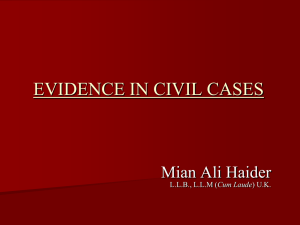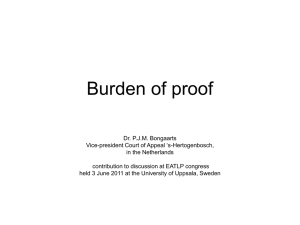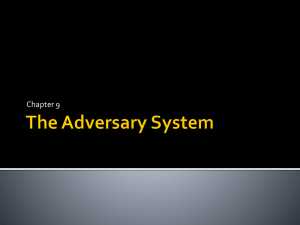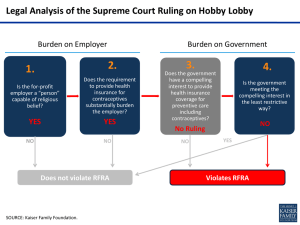The burden of proof
advertisement
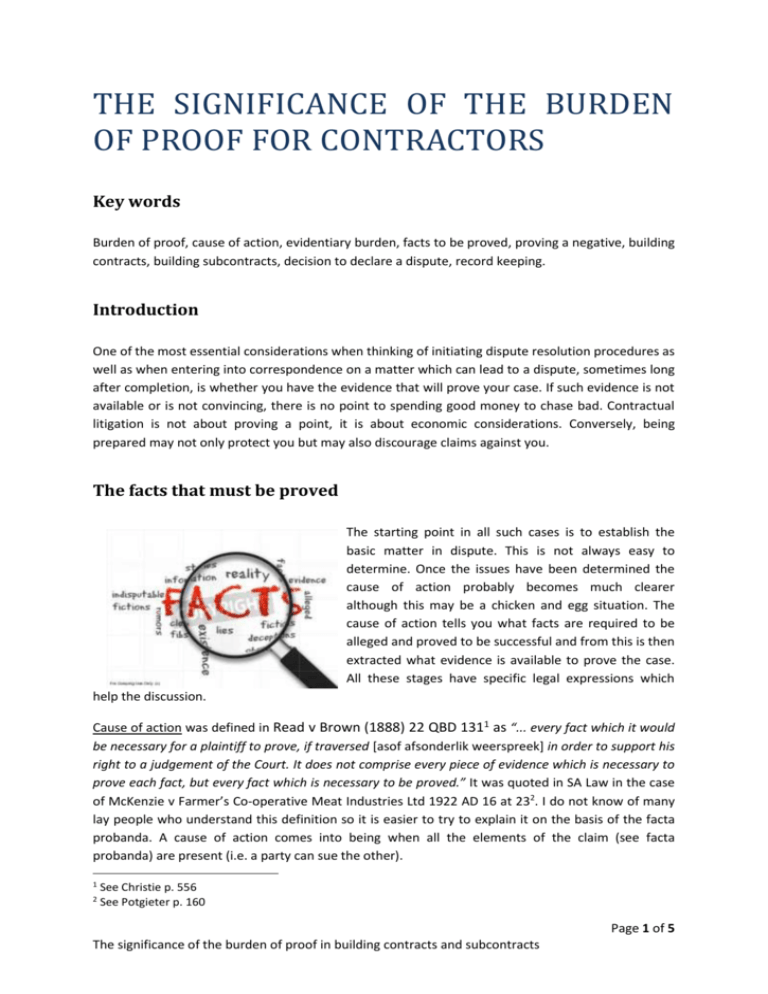
THE SIGNIFICANCE OF THE BURDEN OF PROOF FOR CONTRACTORS Key words Burden of proof, cause of action, evidentiary burden, facts to be proved, proving a negative, building contracts, building subcontracts, decision to declare a dispute, record keeping. Introduction One of the most essential considerations when thinking of initiating dispute resolution procedures as well as when entering into correspondence on a matter which can lead to a dispute, sometimes long after completion, is whether you have the evidence that will prove your case. If such evidence is not available or is not convincing, there is no point to spending good money to chase bad. Contractual litigation is not about proving a point, it is about economic considerations. Conversely, being prepared may not only protect you but may also discourage claims against you. The facts that must be proved The starting point in all such cases is to establish the basic matter in dispute. This is not always easy to determine. Once the issues have been determined the cause of action probably becomes much clearer although this may be a chicken and egg situation. The cause of action tells you what facts are required to be alleged and proved to be successful and from this is then extracted what evidence is available to prove the case. All these stages have specific legal expressions which help the discussion. Cause of action was defined in Read v Brown (1888) 22 QBD 1311 as “... every fact which it would be necessary for a plaintiff to prove, if traversed [asof afsonderlik weerspreek] in order to support his right to a judgement of the Court. It does not comprise every piece of evidence which is necessary to prove each fact, but every fact which is necessary to be proved.” It was quoted in SA Law in the case of McKenzie v Farmer’s Co-operative Meat Industries Ltd 1922 AD 16 at 232. I do not know of many lay people who understand this definition so it is easier to try to explain it on the basis of the facta probanda. A cause of action comes into being when all the elements of the claim (see facta probanda) are present (i.e. a party can sue the other). 1 2 See Christie p. 556 See Potgieter p. 160 Page 1 of 5 The significance of the burden of proof in building contracts and subcontracts Facta probanda are the facts that need to be proved for an action to succeed. In a claim for damages for breach of contract these would briefly be the contract, the existence of the term relied on, a breach of the term and the existence of some prejudice. Within these brief words, lies a multitude of relevant detail which is generally best dealt with by legal practitioners. The facta probanda are proved by the evidence that is provided to the trier. This evidence is referred to as the facta probantia. The detail of the dispute lies in this area. Within these concepts, which are inter-related, lies the essence of any decision as to the correspondence and documentation that is essential to guide a dispute to a successful outcome as well as the potential successful outcome and the limitation of issues in dispute. It is therefore essential that when dealing with a particular problem, written records be generated that provide a written source of evidence that supports the facta probanda, provides a good cause of action and limits the issues in dispute. Obviously this can only take place within a legitimate judicial framework and it is pointless to attempt to use correspondence to alter a fact which is incontrovertible. The burden of proof In any court case, the court uses the principle of the burden of proof, also called the ‘onus’, to assist it in determining the matter before it3. Schwikkard quotes at p. 559 from Heydon & Ockelton4 in explaining onus as “the obligation of a party to persuade the trier of facts by the end of the case of the truth of certain propositions.” The burden of proof in criminal cases is the ubiquitous ’beyond reasonable doubt’ of the TV programmes whereas in civil cases it is only ‘on a preponderance of probabilities’,5 subject to any legislation changing this onus6 in specific situations. Therefore a party who bears the burden of proof succeeds only if the balance of probability is tipped in its favour. If the trier is uncertain or in doubt as to whether the balance has been so tipped then the onus has not been discharged and the other party is successful7. Court cases have sometimes been fought virtually exclusively on the basis of the burden of proof because neither party has sufficient evidence to prove its case so that the party on whom the burden of proof lay failed to discharge its onus and lost the case. The principle regarding who bears the burden of proof is contained in the broad statement that he who avers must prove. In general the plaintiff who seeks an award in his favour must prove his 3 See Schwikkard p. 558 Evidence: Cases and Materials, 4th Edtn, (1996) 15 5 See Ley v Ley’s Executors 1951 3 SA 186 (A) 6 See Schwikkard p. 581 7 See Schwikkard p. 580 who quotes Lord Denning in Miller v Minister of Pensions 1947 2 All ER 372 374: “If the evidence is such that the tribunal can say ‘we think it more probable than not’, the burden is discharged, but if the probabilities are equal it is not”. This judgment was adopted in Ocean Accident and Guarantee Corporation Ltd v Koch 1963 4 SA 147 (A). 4 Page 2 of 5 The significance of the burden of proof in building contracts and subcontracts entitlement thereto. However, this rule may change depending on the pleadings and the law in relation to the dispute. For example, in a contract for the hire of goods or property, the tenant bears the onus of proving that any damage to the hired product during the hire period was not due to his fault. Similarly, where the pleadings include confession and avoidance, such as an admission of assault with the avoidance of self-defence, the burden is on the defendant to prove his defence8. All authors in this subject highlight the fact that the above burden of proof is not the same as the evidentiary burden which moves between parties as the case progresses. The evidentiary burden lies on the party who bears the burden of proof until a prima facie case has been built up from the evidence where after it shifts to the other party who must produce evidence to counter it. This burden may swing backwards and forwards between the parties during the progress of the dispute. How the rules affect contractors and subcontractors Schmidt at para 2.2.1.2 2 (a) to (d) at pp. 2-14 to 2-17 clarifies matters and Schwikkard summarized it as follows in footnote 6 on p. 572: [note this is not a verbatim quotation] “Plaintiff has to prove the existence and relevant terms of the contract as well as any prerequisites in respect of the Defendant’s liability e.g. that he suffered damages or that he performed his own contractual obligations. If the Defendant denies the existence of a contract between him and the Plaintiff, the latter will carry the burden of proving the contract because the Defendant’s defence is a flat denial. The same approach would be followed if the Defendant were to allege that the Plaintiff never suffered any damages or had failed to perform his own contractual obligations. However, … the Defendant would carry the burden of proof should he … plead one of the following [special defences]: (a) that the Plaintiff had released him from the amount due; (b) that the Plaintiff’s claim has prescribed; or (c) that the contract was unlawful… Interruption of prescription must be proved by the Plaintiff.” The law that contracts are enforceable also means that, when making a claim in terms of a contract, the claimant must prove the existence of the contract and all its terms. The problem faced by a claimant is that where a defendant denies liability on the basis of an alleged clause excluding liability, the burden remains on the claimant to prove that the clause does not exist in the contract9. Similarly, in a contract wherein the contractor alleges he has tendered on the basis of drawings that did not include a balcony for which the defendant is deducting money from his contract sum, the burden is on the contractor to prove that the balcony was not shown on the tender drawings. This is sometimes referred to as ‘proving a negative’. The implications of this requirement can be extremely onerous and embarking on an action wherein it becomes necessary to prove a negative should be undertaken with great care. This accentuates the need to ensure that there is proper contract 8 See Mabaso v Felix 1981 3 SA 865 (A). Note that this was a civil case wherein Felix was found liable for Mabaso’s damages and which followed on a criminal case in which Felix was acquitted because the state failed to discharge the onus of proving guilt beyond reasonable doubt. 9 See Stocks & Stocks (Pty) Ltd v TJ Daly & Sons (Pty) Ltd 1979 3 SA 754 (A) wherein the respondent alleged a clause excluding liability for damage and the applicant could not satisfactorily prove to the court that there was no such clause. Page 3 of 5 The significance of the burden of proof in building contracts and subcontracts documentation in place as well as to ensure correspondence comprehensively provides the additional evidentiary foundation needed to convincingly prove the facta probanda to the trier. The other effect that must be raised is the need to have relevant documentation available after the completion of the contract. The effect of presumptions which permeate the law is that when there is a failure such as a slab collapse, there is a presumption that the slab was incorrectly constructed and this generally has the practical consequence of placing the contractor in the position of being guilty unless he can show he is innocent. The typical situations which can arise are shown in the following two examples: A slab collapses in a car park. Investigations show that certain reinforcing bars that were shown in the detailing and bending schedules as having a hook at the one end were installed with no such hook, thereby causing the collapse. The actual background to the story is that the bars arrived on site as designed with the hook for the first concrete pour. During the fixing process, the fixer phoned the engineer to tell him that the hooked bars did not fit into the steel reinforcing cage with the hooks and the engineer instructed him to cut them off. The instruction is never recorded and repeat supplies of the bars for the remaining pours are delivered without the hook because the fixer has diligently told the bar yard to not put a hook in them again. However, when the collapse occurs, none of the people concerned is working for the respective parties so the engineer pulls out his drawings which show hooked bars and the contractor cannot prove why he failed to work to the drawings so the liability for the collapse and its repair rests on his shoulders. Another example is the case where the contractor and his subcontractor install storm water pipes in an area adjacent to a library. On studying the drawings they pick up that the pipes are laid very deep and there appears to be no reason for it. They contact the engineer who agrees and instructs that the pipes are to be laid to shallower depths. As the work is subject to re-measurement on site, nobody bothers to record the change. A few years later there is a cloudburst over the area and the library is flooded. Again there is an investigation and the engineer shows that the pipes were designed to be laid deeper and that this would have averted the flooding. The contractor has no evidence to protect him from liability and is held responsible for the flooding and the repairs to the entire storm water system. Conclusion Construction contracts often extend over long periods, often more than a year, and contractors and subcontractors do not know what potential disputes they will face. Although there are people who believe an open-ended and vague contract offers more opportunity for claims, that is a matter that will depend on who bears the burden of proof in the dispute. If a party wants to claim on such a vague contract, it will potentially face an insurmountable obstacle when it gets to trial and has to discharge its onus. It is therefore far preferable to ensure the contract is clear and comprehensive. In addition, early written communications that address issues that will possibly need to be proved can also come to the assistance of the party who wishes to lay down a solid foundation10. 10 Such correspondence normally excludes any exchanges prior to the agreement of a written contract because of the parol evidence rule as well as the normal ‘entire contract’ clauses included in most building contracts. It Page 4 of 5 The significance of the burden of proof in building contracts and subcontracts Once a potential area of dispute is identified, the cause of action and probable facta probanda should be outlined because, even if the pleadings alter the process, it is unlikely the essential facts to be proved will change significantly. Even if the correspondence results in a dispute as to a fact or the interpretation of a term, this is still beneficial because it clarifies and can limit the issues which need to be referred for dispute resolution. This process may help to eliminate wastage by chasing bad money with good. The need to have specific records available for protection against future claims is similarly of extreme importance and few contracting offices ever attach the necessary attention to this risk. BIBLIOGRAPHY AND REFERENCES USED Christie: Christie RH, The Law of Contract in South Africa, (5th Edtn), 2006, Butterworths, Durban. Schwikkard: Schwikkard, PJ, van der Merwe, SE, Principles of Evidence, 3rd Edtn, 2012, Juta & Co, Claremont. Schmidt: Schmidt, CWH, Rademeyer, H, Law of Evidence, Issue 11, 2011, LexisNexis Durban Potgieter: Potgieter, JM, Steynberg, L, Floyd, TB, Visser and Potgieter Law of Damages, 3rd Edtn, 2012, Juta & Co, Claremont. can also not attempt to alter the contract terms if there is a ‘non-variation’ clause as the prescribed formalities must then be complied with to vary the terms. Page 5 of 5 The significance of the burden of proof in building contracts and subcontracts

